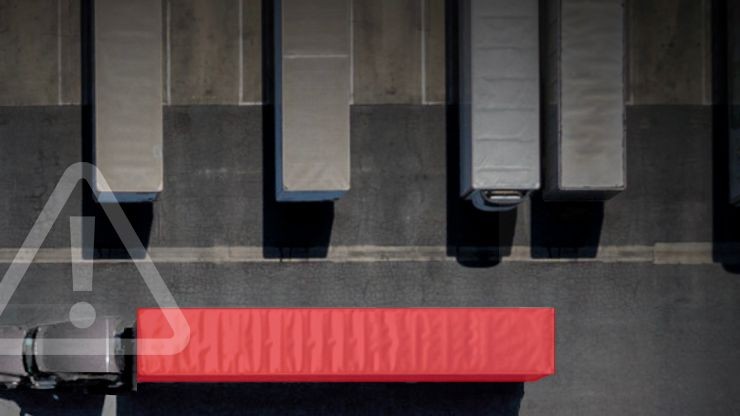Theft Prevention Tips for Shippers

Cargo theft is on the rise. Cargo theft incidents in 2023 were up more than 60% compared to 2022. Nearly $332 million worth of goods were stolen last year according to CargoNet. When you think of cargo theft, you probably imagine goods being stolen out of trucks while at truck stops and parking lots. That is still a major concern, however, there’s a new threat on the rise – strategic cargo theft.
The difference between cargo theft and strategic cargo theft is that strategic cargo theft is theft by fraud and deceptive information to trick shippers, brokers and carriers into giving freight to bad actors. For example, a fraudulent carrier might show up at a pickup location with documents making them seem legitimate and the shipper then unknowingly hands the cargo over to them. Thieves may even post false loads on online load boards to get the information needed to steal a company’s identity, making cybersecurity an important element of cargo protection.
Keep reading for some tips for shippers on cargo theft prevention and to find out how J.B. Hunt’s dedicated security teams work 24/7 to keep your shipments safe.
Best Practices for Cargo Theft Prevention
- Strictly control pickup authorization. Clearly define the process for authorizing pickups and limit the number of authorized personnel with access to pick up information. Maintain a documented list of approved carriers and their drivers.
- Verify carrier identity. Make sure the carrier and driver that come to pick up the load are listed on the documentation from the broker. Check for DOT-required placards with carrier name, DOT number and MC number. Also be sure to check the driver’s photo ID.
- Take photos at pickup. Document and record pictures of the trailer, tractor, license plates, DOT placards, driver’s ID, bill of lading, seal and the interior of the loaded trailer before the doors are shut and the seal is applied. All of this will be crucial information needed by law enforcement and investigators in the event of a theft.
- Verify shipment information. Cross-check the details provided with the information on the original shipping order. If there are any last-minute changes to the pickup arrangements, contact the broker directly to confirm those changes.
- Use unique pickup codes. Implement a system that generates unique pickup codes for each shipment. Only share the pickup code with the authorized carrier and instruct them to provide it at the time of pick up for verification.
- Monitor pickup activity. Keep track of all pickup requests and activities in a centralized system. Regularly review pickup logs and look for any unusual patterns or discrepancies. Conduct regular audits to identify any vulnerabilities in your pickup authorization system.
- Train employees and staff. Educate your employees and staff about the risks of fictitious pickups and the importance of adhering to pick up authorization protocols. Encourage them to report any suspicious activities immediately.
- Implement GPS tracking. Use a carrier with a high-value loads GPS tracking program. High-value and high-risk loads should use covert GPS tracking on shipments to monitor their location and ensure they are headed to the correct destination.
- Use a high-security bolt or 5mm cable seals. Secure your cargo with high-security seals to make it more difficult to access. Don’t use a plastic or metal band seal that can be broken without tools.
- Deploy enhanced securement hardware on high-value loads. Use high strength padlocks, lock rod security devices or figure 8 cable seals at the top of the lock rod bars.
- Secure your pickup location. Have video surveillance and on-site security personnel. Camera coverage of the gate, dock and driver area should be prioritized. Cameras in the pickup area where drivers check in should be mounted low enough to get a good image of the face when the driver is wearing a hat. Also limit who has access to the pickup location.
- Work with law enforcement and cargo theft investigators. In the event of any suspected fictitious pickup attempts or incidents, contact law enforcement immediately. Provide law enforcement and investigators working with the transportation supplier or insurance company with all the relevant information quickly.
- Participate in Transported Asset Protection Association (TAPA), CargoNet and your regional supply chain security organizations. These groups work together to stop and prevent cargo theft. They provide resources for security standards, security best practices and current trends in cargo theft.
Theft Prevention at Every Mile
Keeping your cargo safe can be overwhelming. Ship with J.B. Hunt and let us worry about asset protection so you can focus on your business.
J.B. Hunt has developed an industry-leading security team tasked with protecting customer freight. We have a dedicated team that deploys to assist law enforcement with investigations. This team is made up of former cargo theft investigators and other law enforcement officers tasked with investigating and recovering customer freight. We have a 24/7 security operations center (SOC) dedicated to monitoring and responding to high value loads in transit. This SOC houses our supply chain security team that enforces customer security requirements and is backed by Overhaul for covert tracking technology.
We also have dedicated engineering and technology teams devoted to optimizing cybersecurity to help prevent strategic cargo theft. Our industry-leading technology and analytics can detect many types of carrier fraud and, in many instances, can prevent cargo theft before the load is ever picked up.
Contact a J.B. Hunt representative today and let us take care of supply chain security for you!

